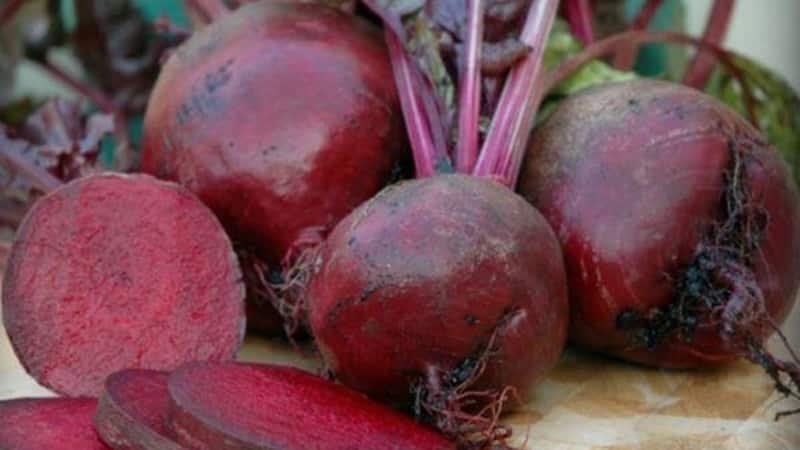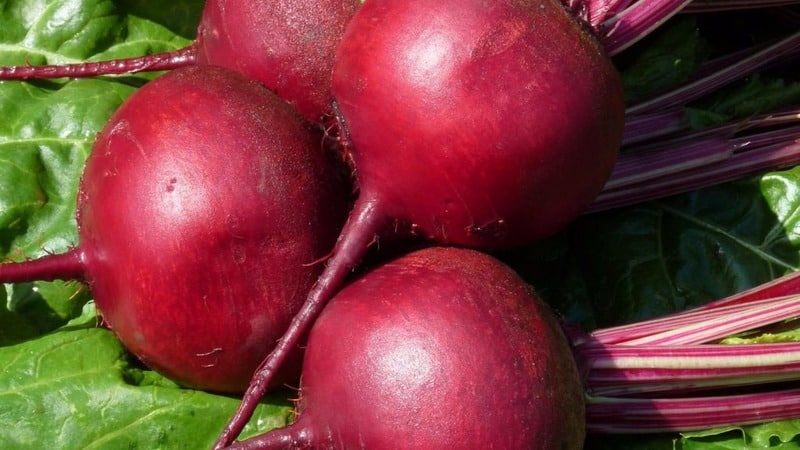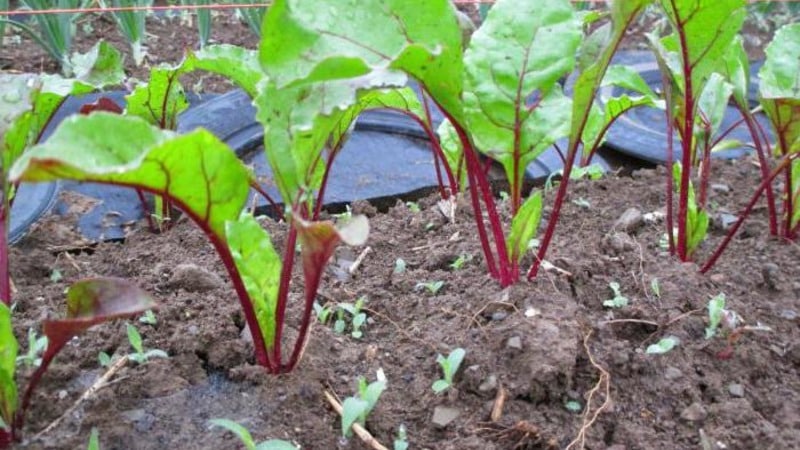High-yielding table beet "Boyarynya": we grow it ourselves without much hassle
Beets are used in the preparation of many dishes. This is an indispensable ingredient in everyone's favorite borscht or herring under a fur coat. For many, beet juice is an important part of their daily diet. The vegetable is used in the treatment of numerous diseases; it is especially valued when boiled.
However, whatever the purpose of the root vegetable, it is more pleasant to eat a beautiful and tasty vegetable. This is exactly what Boyarynya beets from the Russian Hero series are, which has a number of positive characteristics. Its strengths include taste and color. Here it has no equal, which is why the variety has been popular among gardeners for many years.
Description of the variety
The advantages of the Boyarynya variety set it apart from other fellow root crops. The crop is grown in any area, while its taste and product characteristics remain unchanged.
Origin and development
Russian breeders who developed the next root crop were not afraid to call it by the big name Boyarynya. They probably knew that these beets would become the queen of numerous beds. The culture is relatively young, but nevertheless popular in all regions.
This is interesting. Red beets have been known since ancient times, and the fruits themselves were not eaten for a long time. It was valued as a medicinal product, which was recommended by Hippocrates for the treatment of many diseases.In ancient Rome, beets were placed on the table only in front of noble citizens, and Emperor Tiberius Gracchus demanded that the conquered Germans pay tribute in the form of such vegetables.
Peculiarities
Mid-season variety, full fruit ripening occurs in 100–120 days. It is possible to grow in two ways: seedlings and non-seedlings. The latter method is used by residents of the southern regions.
Productivity is high: 3–6 kg of fruits are collected from 1 m2. The variety is highly resistant to cold weather, so when planted early in the ground, it is not afraid of light frosts.
The crop is resistant to flowering and is rarely affected by diseases, but is susceptible to attacks by beet flies and aphids.
Reference! When flowering occurs, the two-year development cycle is disrupted - the beets bloom again instead of forming a fruit.
The culture is recommended for cultivation in all regions, including the Ural District.
Fruit characteristics
The fruits are large, smooth, and have high taste. The average weight ranges from 400–550 g. The shape is round, the color is deep burgundy. The peel is thin and tender, but ripe vegetables can be transported over long distances. The root vegetable has a long shelf life.
The photo shows Boyarynya beets.

The pulp is juicy and tender. Without ringing, sweet, pleasant to the taste.
Reference! The richer the color of the root vegetable, the more minerals and vitamin C it contains.
How to grow
The value of Boyarina lies in the breeding methods. This can be either seedling or non-seedling methods. Let's take a closer look at each of them.

Planting seeds in the ground
This method landings - a real find for many vegetable growers. However, there are some nuances here.
To improve germination, seed material is placed in warm boiled water for 5-6 days. Before this, pre-disinfect in a weak solution of manganese for 15 minutes.
Seeds are sown to a depth of 2 cm; in loose and light soil, they are buried to 4 cm. The distance between holes is 5–7 cm, the distance between rows is 25–30 cm.
The soil must be neutral, since an acidic environment provokes rotting of the fruit. The permissible acidity level is 6-7 pH. Litmus paper will help check the indicator. To do this, dissolve a little earth in a glass of water and drop an indicator into the mixture. When the color is red, the acidity level exceeds the norm: to correct this, wood ash or dolomite flour is added to the soil.
The place for the beds is chosen in a well-lit place: in the shade the fruits will not gain the stated weight.
The soil is prepared in the fall, it is dug up and bird droppings or compost are added.
According to the rules of crop rotation, it is not recommended to plant beets in those beds where crops from the nightshade family previously grew: eggplants, peppers, potatoes, tomatoes - since during their growth and development they draw all the useful substances from the soil. The best predecessors of root vegetables are celery and onions, and if you plant beet seeds after clover, you can reap a particularly rich harvest.
Reference! During clover growth, the soil accumulates a large amount of nutrients (potassium and nitrogen) necessary for the development of many vegetable crops.
Planting is carried out from the end of April, since the variety is resistant to frost and takes root at a temperature of +8 °C.
Sowing seeds for seedlings
The seedling growing method speeds up harvesting by almost a month.
Before planting, seed material is disinfected in a weak solution of manganese for 15 minutes. After disinfection, soak for 2 days in plain water.
The soil is prepared from garden soil and humus in equal quantities. The resulting mixture is disinfected with a dark manganese solution and then placed in planting containers.
Most often they are sown in wooden boxes with a distance of 3-4 cm from each other and a depth of 2 cm.
The first shoots appear after a few days; they need to be provided with a sufficient amount of moisture and light. Daylight should be at least 14 hours - if there is a lack of natural light, take care of a phytolamp in advance.
The accumulation of moisture will lead to rotting of young roots, so emerging shoots should not be flooded.
When 2 true leaves appear, the seedlings are picked, leaving only strong individuals. Since one seed produces 5 sprouts, picking is carried out twice. The second time the transplant is done as soon as 5 true leaves are formed, but often the stage coincides with planting the seedlings in the ground.
After the first picking, fertilizing is carried out with a full complex of minerals with a predominant nitrogen content.
Reference! Nitrogen promotes the growth and development of plants and helps the root system form.
For better adaptation to street conditions, a hardening procedure is carried out. 1 week before planting, the seedlings are taken out into the open air for 30 minutes. Every day the time is increased by 20–30 minutes.
Further care

Before planting in open ground, dig up the soil and add compost or bird droppings. Planting pattern: 5–7 cm between seedlings, at least 25 cm between rows. Before planting, the main root is shortened by one third, that is, a second pick is carried out.Planted to the depth of full root growth. If they bend, the depth of the hole is increased.
After transplanting, the soil is moistened abundantly and covered with film in case frost returns. After this, the seedlings are not watered or fed for 3 weeks, since all the plants’ energies are concentrated on adapting to new conditions.
After 3 weeks, the film is removed and mulch is laid on the beds to protect against pests, weeds and retain moisture. To do this, use straw or sawdust. Watered soil sparingly as the top layer dries out.
Reference! Because of its dark red color, beets received their second name, “buryak.”
Thinning is carried out as the bushes grow, maintaining a distance of 20 cm between them. A month later, when the plantings are dense, the procedure is repeated, but with a smaller distance between the seedlings. If the beds are not thinned, the fruits will be much smaller.
If the seedlings grow poorly, they are fed with a full range of minerals and watered, after the beds are loosened, and weeds are removed. Fertilize beets once a month. Mineral substances alternate with organic ones (bird droppings, mullein infusion or wood ash). The ratio of organic matter to water is 1:15.
Features of care and possible difficulties
It is not necessary to allocate a separate bed for beets: they also grow well in mixed plantings. Good neighbors for root vegetables are cabbage, onions and celery.
Groundwater slows down the growth and development of vegetables. This must be remembered when planting in such an area, planting beets in a safe place.
 According to the rules of crop rotation, root crops are not planted twice in the same beds, since next year the fruits will be smaller and less tasty.Good vegetable predecessors are pumpkin, zucchini, cucumbers, greens and green manure, but beet should not be planted after late cabbage.
According to the rules of crop rotation, root crops are not planted twice in the same beds, since next year the fruits will be smaller and less tasty.Good vegetable predecessors are pumpkin, zucchini, cucumbers, greens and green manure, but beet should not be planted after late cabbage.
Loose soil will accelerate the growth of seedlings, filling the roots with oxygen. Therefore, systematic loosening is combined with weeding of the beds. Weeds pull from the ground many useful substances necessary for the full development of the vegetable.
Diseases and pests
The main diseases of the crop include foma blight, powdery mildew, fusarium rot and black leg. Boyarina is resistant to these diseases, but is affected by pests: aphids and beet flies.
Preventative measures in the fight against beet fly include removing weeds (especially if there is a lot of quinoa on the site) and digging the soil in the fall. When there is a large concentration of insects, the preparations “Accord” and “Ivanhoe” are used.
Beet aphids move from bushes where females lay eggs. The pest sucks sap from plant tissues, causing leaves curl and die. To combat the pest, organophosphate insecticides are used: for example, karbofos.
To avoid the rapid proliferation of insects, plantings must be inspected every day, identifying changes in the condition of the plants.
Harvesting and application
For processing and consumption root crops are collected in July. For long-term storage, they are left in the ground until the end of August. Vegetables peeled from the ground are laid with tops cut off by one third.
 The use of Boyarina is universal: Not only is it suitable for a variety of dishes, but it also goes well with raisins, prunes, apples, eggs and peanuts. Beets are added to herring under a fur coat, vinaigrette and other salads, borscht, and juices. Winter preparations are made from vegetables: freezing, drying, conservation. Root vegetables do not lose their taste when stewed or in desserts.
The use of Boyarina is universal: Not only is it suitable for a variety of dishes, but it also goes well with raisins, prunes, apples, eggs and peanuts. Beets are added to herring under a fur coat, vinaigrette and other salads, borscht, and juices. Winter preparations are made from vegetables: freezing, drying, conservation. Root vegetables do not lose their taste when stewed or in desserts.
Boyarina can be stored for a long time without loss of taste and presentation.
Advantages and disadvantages of the variety
In this section we will look at the positive and negative qualities of culture. Its advantages include:
- cold resistance;
- possibility of propagation through seedlings and without seedlings;
- survival in any climate;
- ease of care;
- high resistance to diseases;
- good yield;
- excellent taste;
- equal size of root crops;
- versatility in cooking;
- possibility of long-term transportation;
- long-term storage.
The negative aspects include:
- susceptibility to attacks by insect pests;
- the need to thin out plantings.
Farmer reviews

The popularity of the vegetable is growing every year. Gardeners leave only positive reviews:
Sergey, Karpinsk: «For our regions, when summer is only one full month long, there is no better beet variety than Boyarynya. We plant the seeds at the end of April–beginning of May, the germination rate is always high. The color and taste of the fruits are wonderful, and they are stored for a long time. I recommend it to every gardener."
Polina, Tver region: “This root vegetable is modern and reliable, growing with little to no special care. It tolerates temperature changes well and produces large yields of burgundy fruits. The collected vegetables are stored in the cellar all winter. Beets are good in salads, vinaigrettes, and borscht.”
Conclusion
Boyarynya beets can be grown using both seedling and non-seedling methods. The variety has high yield (3–6 kg of root crops per 1 m2), stable immunity to diseases, bright color, excellent taste and versatility in cooking.
Unpretentiousness in care throughout the entire growing season and cold resistance allow you to grow vegetables in any climate.